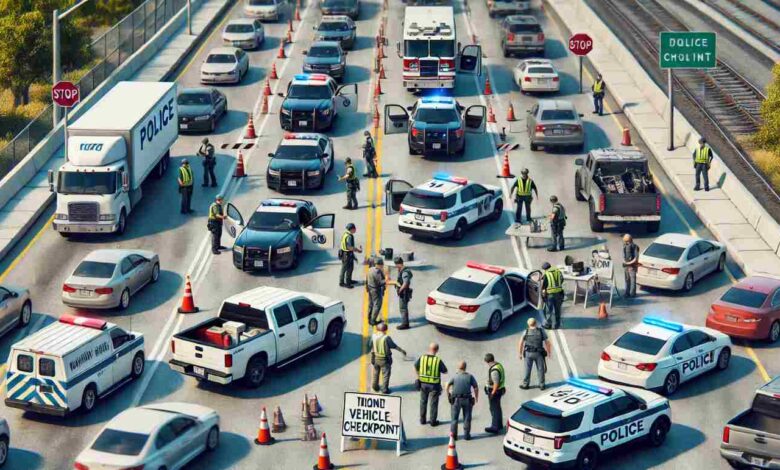Understanding ‘Random Checkpoint’ in Law Enforcement Operations

In the world of law enforcement, random checkpoints play an essential role in maintaining safety, law and order. A random checkpoint refers to a sudden, unannounced stop that law enforcement officers set up on the roads or specific locations to check vehicles, individuals, or both.
What is a Random Checkpoint?
A random checkpoint is a temporary roadblock set up by law enforcement officers without prior notice or specific targeting. These checkpoints are typically used to stop vehicles or pedestrians to check for potential violations, such as driving under the influence of alcohol or drugs, illegal substances, expired documentation, or even to spot stolen goods.
The main objective is not only to catch offenders but also to act as a deterrent, making potential criminals think twice about committing an offense.
The randomness of these checkpoints is crucial because it reduces predictability and prevents offenders from evading detection by avoiding certain areas at specific times. Instead of choosing the same locations or setting the checkpoints at certain hours, law enforcement officers randomly set up these checkpoints at different times and places, which increases their effectiveness.
Why Are Random Checkpoints Important?
Random checkpoints are essential for various reasons, particularly in terms of enhancing safety, preventing crime, and enforcing the law. Let’s take a closer look at why these operations are so important:
Public Safety: One of the most significant benefits of random checkpoints is that they directly contribute to the safety of the public. Officers are able to monitor traffic and ensure that drivers are abiding by the law. By stopping vehicles randomly, police officers can catch impaired or reckless drivers before they cause accidents.
Crime Prevention: Random checkpoints also act as a deterrent for potential criminals. When people know that there is a high possibility of being stopped at any given time, they are less likely to engage in illegal activities. For example, a person transporting stolen goods may think twice about driving through a checkpoint, knowing that law enforcement could be there at any time.
Law Enforcement: These checkpoints allow law enforcement officers to enforce traffic laws and ensure that drivers and pedestrians are following rules such as wearing seat belts, not texting while driving, and having proper documentation. Random stops can uncover a range of violations, from expired licenses to more serious offenses like drug possession or DUI.
Reducing Drunk Driving: One of the most common reasons for setting up random checkpoints is to catch drunk or impaired drivers. DUI checkpoints aim to identify drivers under the influence of alcohol or drugs, helping reduce the number of accidents and fatalities caused by impaired driving.
Preventing Drug and Human Trafficking: Random checkpoints are often used to detect and prevent drug trafficking, human trafficking, and other illegal activities. By stopping vehicles at random, law enforcement officers can identify suspicious behavior, illegal substances, and individuals who might be involved in human trafficking or other criminal activities.
How Do Random Checkpoints Work?
The implementation of random checkpoints follows specific procedures to ensure they are lawful and effective. Here’s how they typically work:
Setting Up Checkpoints: Law enforcement officers decide on a random location, which is often chosen for its strategic position such as high-traffic areas, or locations with a history of criminal activity. The randomness of the checkpoints is key to ensuring that no one can avoid them.
Stopping Vehicles or Pedestrians: At the checkpoint, officers stop passing vehicles or pedestrians. They ask for necessary documentation such as driver’s licenses, registration, and proof of insurance. Officers may also observe the driver’s behavior and look for signs of impairment, such as slurred speech or bloodshot eyes.
Performing Inspections: In addition to checking documentation, law enforcement officers may perform searches of vehicles if they suspect that illegal substances, weapons, or stolen goods are present. If officers have reasonable cause to believe that a crime is being committed, they may search the vehicle further and take necessary legal action.
The Purpose of Random Stops: The purpose of these stops is to enforce compliance with laws and prevent any potential violations. Officers may use the opportunity to inform drivers about current laws, safety tips, or raise awareness about community initiatives aimed at reducing crime.
Duration of the Checkpoint: These checkpoints typically last for a few hours, depending on the area and the type of enforcement activity taking place. Law enforcement officers set up and remove the checkpoints quickly to maintain their unpredictability and effectiveness.
Legal Considerations Regarding Random Checkpoints
While random checkpoints are an effective tool for law enforcement, they must be carried out legally to protect individual rights and avoid constitutional violations. Random checkpoints are subject to specific regulations and constitutional rules, primarily concerning the Fourth Amendment in the United States.
Fourth Amendment Rights: In the U.S., the Fourth Amendment protects citizens from unreasonable searches and seizures. To avoid violating these rights, random checkpoints must meet specific guidelines:
Public Safety Focus: Checkpoints must focus on public safety and law enforcement, not on searching for specific criminals or illegal activity.
Minimal Intrusion: The checkpoint should minimally interfere with a person’s daily routine, meaning that the stop should not be unnecessarily intrusive.
Clear Guidelines for Officers: Officers conducting the checkpoint should follow clear, uniform guidelines to ensure that every individual is stopped randomly and not based on profiling or discrimination.
Notification: Often, law enforcement agencies must inform the public about the existence of checkpoints in advance. For instance, while the checkpoint may be unannounced in its location, there might be signs, notices, or even public announcements indicating that checkpoints will be set up.
Pros and Cons of Random Checkpoints
While random checkpoints have significant benefits, they are not without their drawbacks. Let’s look at both the pros and cons.
Pros:
Crime Deterrence: Random checkpoints discourage criminal activities such as drug trafficking, driving under the influence, and theft.
Increased Safety: By catching impaired drivers or checking for other violations, random checkpoints contribute to safer roads and communities.
Cost-Effective: Law enforcement can conduct random checkpoint with minimal resources, often using a few officers, barricades, and patrol vehicles.
Public Awareness: They help raise awareness about the importance of following the law and may encourage citizens to follow traffic rules more carefully.
Cons:
Infringement of Privacy: Some individuals believe that random checkpoints violate their privacy rights by subjecting them to unnecessary stops.
Risk of Racial Profiling: There is a potential for racial profiling or discrimination during random stops, where officers may focus on certain individuals based on their race or ethnicity.
Public Discomfort: Random checkpoint may cause inconvenience and discomfort to law-abiding citizens who are simply going about their business.





